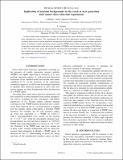| dc.contributor.author | Strigari, L. | |
| dc.contributor.author | Billard, Julien | |
| dc.contributor.author | Figueroa-Feliciano, Enectali | |
| dc.date.accessioned | 2014-06-12T17:17:39Z | |
| dc.date.available | 2014-06-12T17:17:39Z | |
| dc.date.issued | 2014-01 | |
| dc.date.submitted | 2013-07 | |
| dc.identifier.issn | 1550-7998 | |
| dc.identifier.issn | 1550-2368 | |
| dc.identifier.uri | http://hdl.handle.net/1721.1/87749 | |
| dc.description.abstract | As direct dark matter experiments continue to increase in size, they will become sensitive to neutrinos from astrophysical sources. For experiments that do not have directional sensitivity, coherent neutrino scattering from several sources represents an important background to understand, as it can almost perfectly mimic an authentic weakly interacting massive particle (WIMP) signal. Here we explore in detail the effect of neutrino backgrounds on the discovery potential of WIMPs over the entire mass range of 500 MeV to 10 TeV. We show that, given the theoretical and measured uncertainties on the neutrino backgrounds, direct detection experiments lose sensitivity to light (∼10 GeV) and heavy (∼100 GeV) WIMPs with a spin-independent cross section below 10[superscript −45] and 10[superscript −49] cm[superscript 2], respectively. | en_US |
| dc.description.sponsorship | National Science Foundation (U.S.) (Grant NSF-0847342) | en_US |
| dc.language.iso | en_US | |
| dc.publisher | American Physical Society | en_US |
| dc.relation.isversionof | http://dx.doi.org/10.1103/PhysRevD.89.023524 | en_US |
| dc.rights | Article is made available in accordance with the publisher's policy and may be subject to US copyright law. Please refer to the publisher's site for terms of use. | en_US |
| dc.source | American Physical Society | en_US |
| dc.title | Implication of neutrino backgrounds on the reach of next generation dark matter direct detection experiments | en_US |
| dc.type | Article | en_US |
| dc.identifier.citation | Billard, J., E. Figueroa-Feliciano, and L. Strigari. “Implication of Neutrino Backgrounds on the Reach of Next Generation Dark Matter Direct Detection Experiments.” Phys. Rev. D 89, no. 2 (January 2014). © 2014 American Physical Society | en_US |
| dc.contributor.department | Massachusetts Institute of Technology. Department of Physics | en_US |
| dc.contributor.department | MIT Kavli Institute for Astrophysics and Space Research | en_US |
| dc.contributor.mitauthor | Billard, Julien | en_US |
| dc.contributor.mitauthor | Figueroa-Feliciano, Enectali | en_US |
| dc.relation.journal | Physical Review D | en_US |
| dc.eprint.version | Final published version | en_US |
| dc.type.uri | http://purl.org/eprint/type/JournalArticle | en_US |
| eprint.status | http://purl.org/eprint/status/PeerReviewed | en_US |
| dspace.orderedauthors | Billard, J.; Figueroa-Feliciano, E.; Strigari, L. | en_US |
| dc.identifier.orcid | https://orcid.org/0000-0001-9285-5556 | |
| mit.license | PUBLISHER_POLICY | en_US |
| mit.metadata.status | Complete | |
